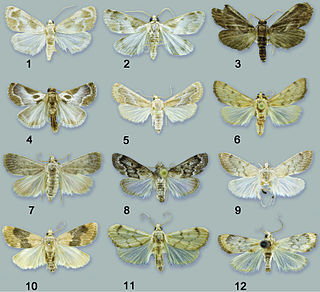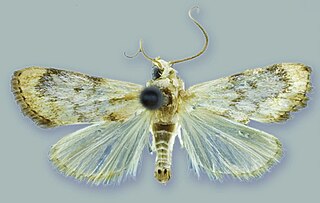
Schacontia is a genus of moths of the family Crambidae described by Harrison Gray Dyar Jr. in 1914.

Apogeshna stenialis, the checkered apogeshna moth, is a moth in the family Crambidae. It is found from Maine to Florida, west to Alabama, Illinois and Ohio. It is also found in Mexico, Panama, Honduras, and the Dominican Republic.

Schacontia medalba is a moth of the family Crambidae described by William Schaus in 1904. It is found in Brazil and Peru.

Schacontia chanesalis is a moth of the family Crambidae described by Herbert Druce in 1899. It is found in Mexico, Guatemala, Costa Rica and Venezuela.

Schacontia umbra is a moth of the family Crambidae described by Maria Alma Solis and Paul Z. Goldstein in 2013. It is found in central Ecuador.

Schacontia speciosa is a moth of the family Crambidae described by Maria Alma Solis and Paul Z. Goldstein in 2013. It is found in south-eastern Brazil.

Schacontia themis is a moth of the family Crambidae described by Maria Alma Solis and Paul Z. Goldstein in 2013. It is found on the Cayman Islands and in Brazil, Costa Rica, Cuba, the Dominican Republic, Florida, Jamaica, Mexico, Panama, Puerto Rico and Venezuela.

Schacontia nyx is a moth of the family Crambidae described by Maria Alma Solis and Paul Z. Goldstein in 2013. It is found in northern Venezuela.

Schacontia clotho is a moth of the family Crambidae described by Maria Alma Solis and Paul Z. Goldstein in 2013. It is found in southern Ecuador.

Schacontia lachesis is a moth of the family Crambidae described by Maria Alma Solis and Paul Z. Goldstein in 2013. It is found in central Brazil and Bolivia.

Schacontia atropos is a moth of the family Crambidae described by Maria Alma Solis and Paul Z. Goldstein. It is found in northern Venezuela.

Schacontia ysticalis is a moth of the family Crambidae described by Harrison Gray Dyar Jr. in 1925. It is found in Mexico, Costa Rica, Honduras, Nicaragua, Venezuela and Bolivia.
Cosmopterosis spatha is a moth in the family Crambidae. It was described by Maria Alma Solis in 2009. It is found in Costa Rica, where it has been recorded from the provinces of Alajuela, Guanacaste, Limon and Puntarenas. It is found at altitudes between 50 and 1,600 meters.
Cosmopterosis hispida is a moth in the family Crambidae. It was described by Maria Alma Solis in 2009. It is found in Brazil.
Scirpophaga gilviberbis is a moth in the family Crambidae. It was described by Philipp Christoph Zeller in 1863. It is found on the Comoros and in the Democratic Republic of the Congo, Kenya, South Africa, Zambia, India, Indonesia, Myanmar, Singapore, Thailand and Vietnam.
Cliniodes opalalis is a moth in the family Crambidae. It was described by Achille Guenée in 1854. It is found in Central America, north to southern Mexico. It is also found in Cuba, Jamaica and in the Andes from Colombia to Bolivia. It has also been recorded from northern Venezuela, Trinidad and Tobago and north-eastern Brazil.
Cliniodes muralis is a moth in the family Crambidae. It was described by James E. Hayden in 2011. It is found in the Dominican Republic and Cuba.

Frechinia helianthiales is a moth in the family Crambidae. It was described by Mary Murtfeldt in 1897. It is found in North America, where it has been recorded from Arizona, Illinois, Manitoba, Missouri and Oklahoma, south to Mexico.
Lamprosema sibirialis is a moth in the family Crambidae. It was described by Pierre Millière in 1879. It is found in Russia, Korea, China and Japan.
Sufetula carbonalis is a moth species in the family Crambidae. It was described by James E. Hayden in 2013. It is found in North America, where it has been recorded from Florida.













